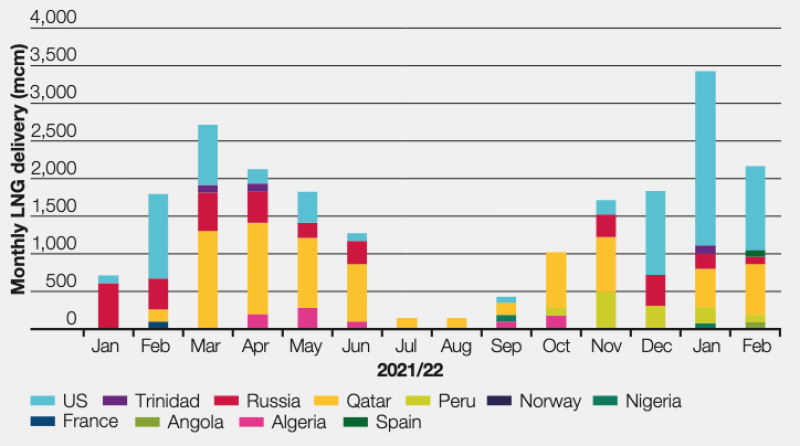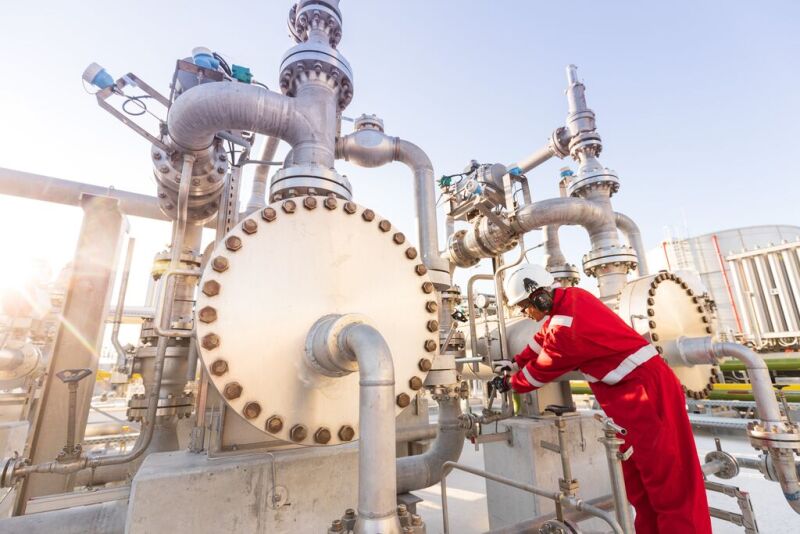UK infrastructure that regasifies liquefied natural gas (LNG) for further transit via pipeline to the Netherlands and Belgium is emerging as a key element in Europe’s evolving strategy to reduce its dependence on Russian gas this year by two-thirds.
In its annual Summer Gas Outlook published on 14 April, the UK’s National Grid plc, a British multinational electricity and gas utility company, noted that the UK will increase its gas exports over the next 6 months to help Europe fill its gas storage sites ahead of next winter.
European gas storage was at 27% at the end of this winter as compared to 30% the same time a year ago.
The UK has been a net importer of gas since 2005, covering 50% of demand with its own production from the North and Irish Seas plus associated petroleum gas from oil fields.
Norway supplies about 30% of UK imports via pipeline, with LNG from Qatar, the US, and Russia accounting for a bit more than 15%, according to the Outlook.
Any surplus gas in the system can then be exported to Europe via the BBL pipeline to the Netherlands (Bacton to Balgzand) or through the Interconnector pipeline to Belgium (Bacton to Zeebrugge.) The ability to regasify LNG from anywhere in the world and then deliver it to Europe by pipeline makes Britain an “energy bridge” that can wean Europe off Russian energy while longer-term solutions are put into place.
This summer, UK gas exports to the EU could reach 5.1 Bcm, far beyond the volumes of 2021, when exports totaled only 0.7 Bcm because cold summers had drawn down the UK’s gas reserves, according to National Grid which noted that the increased exports are to be based on “commercial agreements” as opposed to intergovernmental agreements.
LNG is expected to play a major role in boosting EU gas supplies from new sources globally, with more cargos directed in the near term to the UK’s three regasification terminals—Grain LNG (the UK’s largest) on the Thames Estuary, Kent; and the South Hook and Dragon regasification terminals in Wales.
The UK is Europe’s second-largest LNG importer after Spain and, given its subsea pipeline connections to the continent, it is also a gas transit state to the EU.
So far, the US has agreed to increase LNG exports to Europe by 15 Bcm and Qatar has promised not to redirect Europe-bound cargoes to Asia as is the practice when buyers in Asia offer higher premiums to sellers.

Fred Hutchison, chief executive of the US trade group LNG Allies, confirmed to Reuters that delegations from Latvia and Estonia, as well as diplomats from Bulgaria, Estonia, France, Germany, Hungary, Latvia, and the UK toured the Golden Pass LNG export project in Sabine Pass, Texas, in early April and met in Houston with US shale gas producers.
Top executives from Chesapeake Energy, Coterra Energy, EOG Resources, and EQT Corp. participated in the event which was intended to foster discussion of how US energy producers could assist Europe in replacing Russian imports of oil, coal, and LNG.
The meeting co-organized with the American Exploration and Production Council touched also on the topic of building new infrastructure in both Europe and in the US, echoing testimony that Pioneer Natural Resources Chief Executive Scott Sheffield gave the same day when he told a congressional hearing that new LNG facilities are needed in the northeast, according to Reuters and C-SPAN.
As for Europe, Germany—which had staked its energy security largely on Russian pipeline gas—now expects to commission its first LNG regasification plant in 2026. In March, Germany’s Economic Minister Robert Habeck was in Doha lining up a long-term supply contract with Qatar.
Meanwhile, Algeria has agreed to increase gas exports to Italy through the Trans-Mediterranean Pipeline to Sicily via Tunisia under an agreement announced during Italian Prime Minister Mario Draghi’s visit to Algiers for talks with Algerian president Abdelmadjid Tebboune.
Italy, like the rest of the EU, relies on Russia for about 40% of its energy imports. In 2021, the EU imported 155 Bcm of Russian gas which represented about 45% of EU gas imports, nearly 40% of total gas consumption, according to the Paris-based International Energy Agency.


